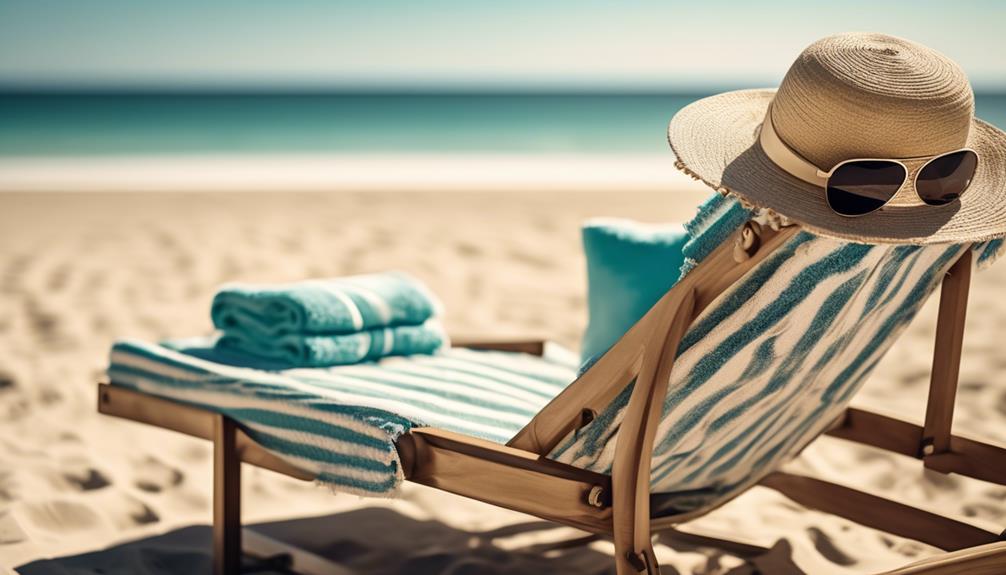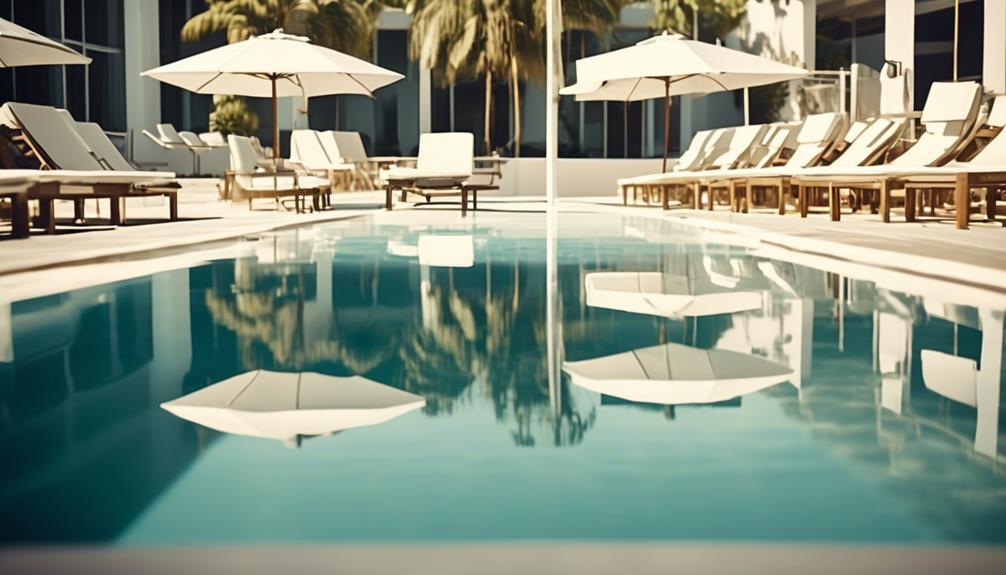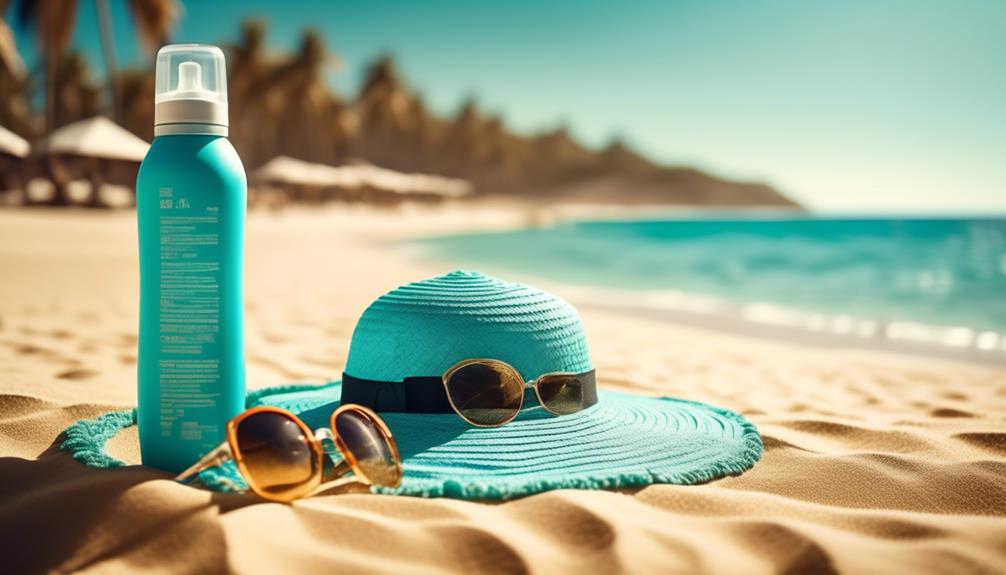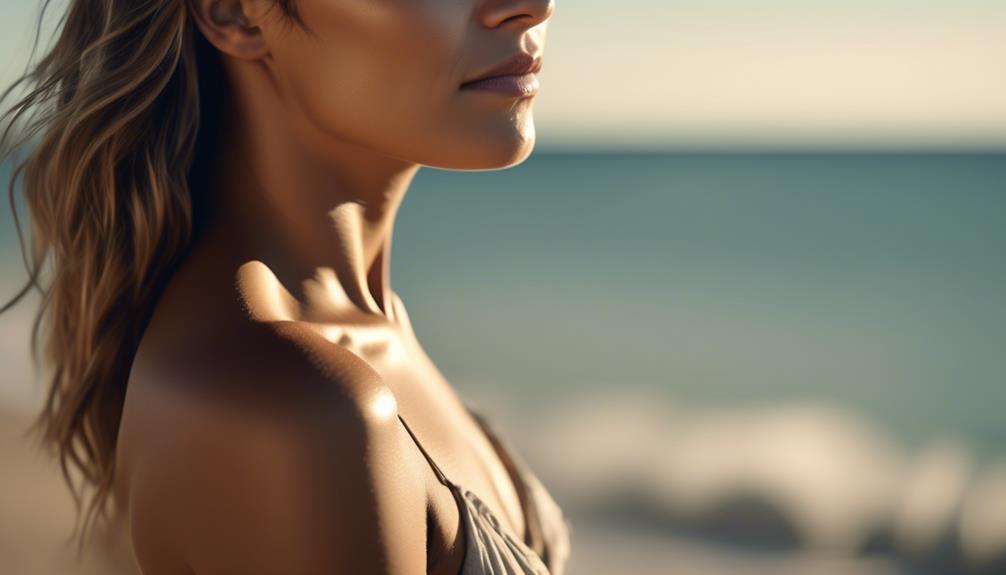You’ve slathered on sunscreen, you’ve donned the shades, and you’ve waited for that golden sheen, yet here you are, looking more like a lobster than a sun-kissed beach deity.
Let’s face it, you’re frustrated and a bit worried; after all, no one wants to play with fire when it comes to their skin. Maybe it’s your skin type, or perhaps you’re missing a crucial piece of the UV puzzle. Could it be the SPF you’re trusting isn’t the knight in shining armor you thought it was?
As you wonder about the invisible line between a healthy glow and a fiery burn, you’re not alone in this sizzling dilemma. Stick around, because understanding the fickle art of tanning versus burning could save your skin and your summer vibes.
Key Takeaways
- The Fitzpatrick skin type scale categorizes skin types based on their reaction to the sun.
- Fair complexions that freckle easily are likely Type 1 or 2 and are more prone to burning.
- Skin rich in melanin, such as Type 5 or 6, is less likely to burn but still needs sun protection.
- Tanning is a sign of skin damage caused by UV radiation, and sunscreen with SPF 30 or higher is essential for protecting the skin from premature aging and reducing the risk of skin cancer.
Understanding Skin Types
You’ve probably heard the buzz about skin types, but knowing your own is a game-changer when it comes to basking in the sun safely. The Fitzpatrick skin type scale isn’t just some fancy dermatological term; it’s your personal roadmap to understanding how your skin dances with the sun.
If you’ve got a fair complexion that freckles faster than you can say ‘Where’s my sunscreen?’, you’re likely rocking a Type 1 or 2. Redheads and blondes, you’re the VIPs in this category. Your delicate skin is like a sensitive soul, so full of melanin dreams, yet so likely to burn. Embrace it, love it, but for heaven’s sake, protect it!
On the flip side, if your skin’s rich with melanin, deeply hued and rarely scorched, you might be a Type 5 or 6. But don’t let that natural glow fool you; UV radiation doesn’t discriminate. It’s an equal-opportunity damager. So, even though you’re not as likely to turn into a lobster under the sun, don’t skimp on the SPF.
The Science of Melanin
You’ve heard about melanin, right? It’s your body’s personal bodyguard against the sun’s fierce rays, kicking into gear within a couple of days after you’ve soaked up some sun.
But have you ever wondered what flips the switch on your skin’s tan mode or why some of us burn faster than we can say ‘ouch’?
Melanin Production Process
Melanin is your skin’s tiny warriors, melanocytes, spring into action under the sun’s glare, producing the pigment that gives your complexion its unique glow.
Ever wondered why some friends rock a golden tan while you’re left with a lobster vibe? It’s all about the melanin production process.
Here’s some important points:
- Sun’s Kiss: UV rays from the sun hit your skin, prompting melanocytes to ramp up the production of melanin.
- Color Code: The amount of melanin in your skin dictates whether you’ll flaunt darker skin with a tan or sport lighter skin with a burn.
- Genetic Lottery: Your DNA plays matchmaker, deciding your baseline melanin levels and how your skin reacts to sunny affairs.
Stay savvy about your glow-up game!
Factors Affecting Melanogenesis
Understanding the kaleidoscope of factors that influence melanogenesis is key to unlocking why your skin might tan like a beach god or burn like toast.
Your skin type, assessed by the Fitzpatrick scale, is the VIP in this tanning-burning saga. If you’re on the fairer side, you might find yourself redder than a lobster after some serious sun exposure.
UV radiation is like a double-edged sword; it kickstarts melanin production, but too much and you’re in burn city. Slather on that SPF 30 to shield your skin, while still letting it do its melanin magic.
Genes play a big part too—they’re the behind-the-scenes maestros of your skin’s tanning tune.
And don’t forget, your immune system and overall health are the secret ingredients to your tan’s glow-up or no-show.
UV Radiation Explained
Let’s get real about the rays that give you that tan—UV radiation is no joke, and here’s why it demands your attention.
When you’re soaking up the sun’s UV rays, you might think you’re on your way to that golden glow, but what’s actually happening is a full-on assault on your skin cells. That ‘healthy’ tan is your skin scrambling to defend itself, and not everyone’s armor is built the same.
Here’s some important points about UV radiation:
- Tanning Equals Damage: Every time you tan, you’re damaging your skin. This isn’t just about a little redness; it’s your body’s SOS, activating melanin to protect against UV’s harmful effects.
- Know Your Skin Type: Your skin type isn’t just about your summer look; it’s a critical factor in how you should shield yourself from the sun. The Fitzpatrick skin type system is your bestie in understanding your risk level.
- Play It Safe: Sunscreen isn’t optional—it’s your frontline defense. Slather on SPF 30 to shield your skin from premature aging and to seriously decrease the risk of skin cancer.
Impact of Genetics
You’ve probably noticed how some friends tan like they’re kissed by the sun, while you might just turn into a lobster. That’s your genes playing beach DJ, spinning a track of melanin that decides whether you’ll bronze up or burn down.
It’s all about the skin type determinants and the melanin production variability that make your sun dance totally unique to you.
Skin Type Determinants
Your skin’s tan or burn reaction is all in the genes, with melanin levels calling the shots on whether you’ll bronze up or resemble a lobster post-beach day. Wondering why your BFF gets a golden glow while you’re left with a reddish souvenir? It’s all about your skin type.
Here’s some important details on what’s behind your sun-kissed dreams or burn nightmares:
- Melanin Magic: More melanin equals better UV defense and chances for that envious base tan.
- Fitzpatrick Scale: This scale classifies your skin type from 1-6. The Skin Cancer Foundation says lower numbers tend to burn easier. Thanks, genetics!
- Gene Pool Party: Your skin’s ability to tan or turn tomato-red is a lottery with 63 gene variations in the mix.
Melanin Production Variability
Moving from the Fitzpatrick skin typing, it’s clear that the genetic lottery doesn’t stop there—your melanin’s production level is also a VIP guest at the gene pool party, with a major say in your summer skin saga.
When you’re exposed to the sun, it’s like a backstage pass for UV rays to mix it up with your skin cells. But here’s the catch: not all of us are blessed with the same tanning DJ. For some, melanin production variability means they’re more likely to end up with a sunburn at home rather than that sun-kissed glow.
It’s all in the genes. Those tiny bosses inside you decide whether you’ll bronze like a goddess or turn tomato-red. So next time you’re reaching for that SPF, remember—it’s personal.
Sun Exposure Timing
To dodge the fiercest UV rays and sidestep sunburn, it’s savvy to steer clear of basking in the sun from 10 a.m. to 4 p.m. That’s when the sun’s ultraviolet (UV) rays are out to play hardball, and trust me, they’re not playing for team ‘Golden Glow.’ Instead, they’re gunning for your skin, regularly doling out more than just a cute tan – we’re talking serious health risks.
Don’t let that scare you away from chasing that sun-kissed look.
Here’s the deal:
- Kick-Start with Caution: Begin your tanning sessions with short, sweet doses of sunshine. Gradually up the ante as your skin vibes with the UV and starts to build that base tan.
- Tan-Smart Products: Before you step out, slather on some tan accelerators. They’re like your skin’s BFFs, prepping it to soak up the sun without turning lobster-red.
- Evening Love: Post-4 p.m. sunshine is like that chill friend who’s cool without trying too hard. It’s the perfect time to wind down with a gentler tanning sesh.
Sunscreen and Protection
While you’re mastering the art of the late-day tan, don’t forget the real MVP: sunscreen, because protecting your skin’s health is just as crucial as nailing that bronzed look. Seriously, sunscreen and protection are your skin’s besties. Slather on that SPF 30 or higher. It’s your shield against the sun’s fierce vibes – think premature aging, sunburn, and, yikes, even skin cancer.
Stay woke during those peak hours, from 10 a.m. to 4 p.m., when the sun’s throwing major UV shade. And let’s bust a myth – tanning beds? They’re not your friends. They’re just as shady as the midday sun and up the ante on skin cancer risks. No thanks!
Self-tanners can give you that glow without the growl of UV damage. These products contain a little something called DHA that cozies up with your dead skin cells to fake that tan. Genius, right?
And don’t just stop at sunscreen. Drink plenty of water to keep your skin hydrated and happy. Seek some shade, throw on a hat, and live your best sun-safe life. Remember, a true glow-up is about keeping it healthy and fierce.
Myths About Tanning
You might think that lounging in those tanning beds will give you that golden hue that’ll make you feel better about yourself.
But , let’s get real – you’re playing with fire, literally.
Here’s some tips on what’s true and what’s as fake as a bad spray tan:
- A ‘base tan’ isn’t your knight in shining armor. It won’t protect you from a sunburn, so slather on that sunscreen.
- Tanning beds? They’re not your BFF. These glow-up coffins bump up your risk of skin cancer just like the sun, so don’t be fooled.
- Want to see results without the ouch? UV-free tans are your new go-to. Get that sun-kissed look with zero regrets.
Preventing Skin Damage
Slathering on that SPF 30 is your skin’s VIP pass to fighting off those sneaky UV rays and keeping your glow game strong, minus the damage. You’re not just upping your selfie stakes; you’re committing to preventing skin damage that can lead to some serious downers like early aging and, yikes, cancer.
Between those peak sun hours of 10 a.m. and 4 p.m., play it cool and seek some shade. And dabbling in that tan from a bottle? It’s not just for reality stars! Opting for a self-tanner can give you that sun-kissed look without the ouch or the ouch-what-did-I-just-do-to-my-skin regret.
Don’t forget to keep your eyes on the prize with regular skin self-exams. Spot something sus? It’s time to see a doctor. They’ll give you the medical advice you need, and it’s all backed by serious smarts from academic research institutions and peer-reviewed studies.
Frequently Asked Questions
Why Do I Get Burned and Not Tan?
You’ve probably noticed you’re getting sunburned instead of that golden tan you’re after. It’s all about your skin’s reaction to UV rays.
If you’re slathering on SPF 30 and still turning into a lobster, your skin type might just be more prone to burning.
Remember, tanning beds aren’t the answer either. They’re risky business for your skin.
Why not try a self-tanner for that glow without the ouch?
Stay safe and fabulous!
Will I Eventually Get a Tan if I Keep Burning?
Burning is your skin’s cry for help, a big red flag that you’re hurting, not helping it.
If you keep burning, you’re risking serious damage instead of scoring that tan. Embrace your natural shade or go for a faux glow with a self-tanner. Your skin will thank you, and you’ll still look fire!
How Do I Get My Skin to Tan Instead of Burn?
Switch up your game with high SPF sunscreen and shorter sun sessions.
Avoid those scorching peak hours.
Maybe ditch the burn for a faux tan – try a cool spray tan or a slick self-tanner.
Protect your skin and rock that bronzed look safely.
Who needs the burn when you can fake it ’til you make it?
Why Will My Skin Not Tan?
Well, it’s all about your unique skin type and the way it reacts to the sun.
To get that sun-kissed look, you’ve gotta play it smart with your sun game.
Make sure you’re layering on that SPF and keeping your sunbathing sessions short.
Don’t forget to rock some cool shades and a hat for that extra protection!




